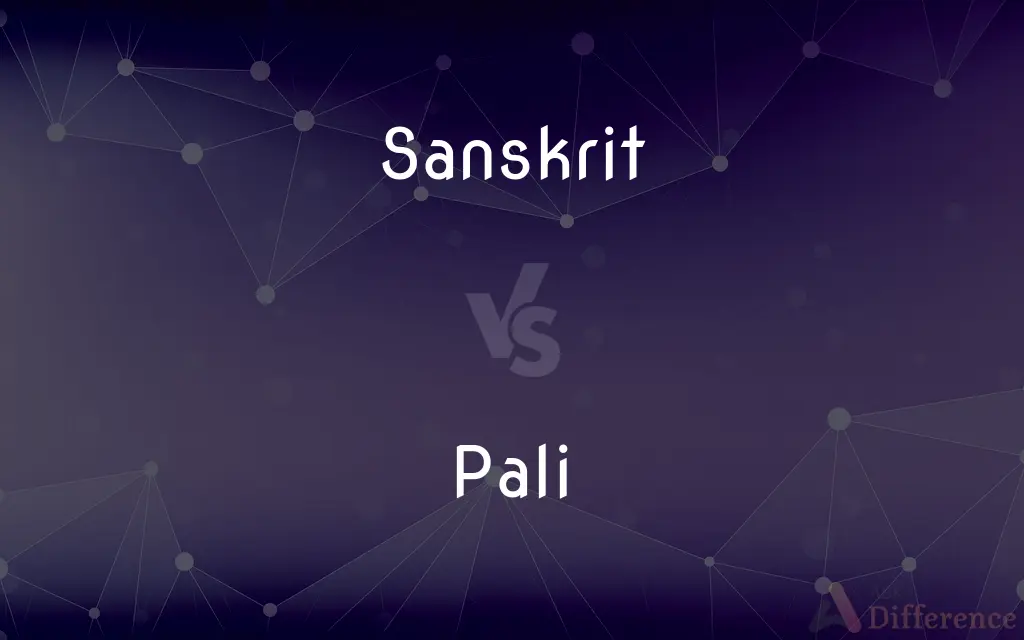Sanskrit vs. Pali — What's the Difference?
By Tayyaba Rehman — Updated on October 12, 2023
Sanskrit is an ancient Indo-European language of India, foundational to Hinduism, Buddhism, and Jainism, while Pali is a Middle Indo-Aryan language primarily used in Theravāda Buddhist scriptures.

Difference Between Sanskrit and Pali
Table of Contents
ADVERTISEMENT
Key Differences
Sanskrit is an ancient language that originated in the Indian subcontinent and served as a liturgical language for Hinduism, Buddhism, and Jainism. Pali, on the other hand, is a language closely related to Sanskrit and is primarily known as the canonical language of the Theravāda Buddhist scriptures.
The grammatical structure of Sanskrit is complex and is known for its rich morphology and precise phonetics. Pali, while derived from a similar linguistic branch, has simpler grammar and is often seen as more accessible than Sanskrit.
Historically, Sanskrit has been the medium of many literary, philosophical, and scientific works in India. Pali, although less widespread, has been crucial in preserving the teachings of the Buddha, especially in the Theravāda tradition.
The influence of Sanskrit is evident in many modern Indian languages, as it has contributed substantially to their vocabularies and grammatical structures. Pali, while not as influential in everyday languages, remains essential in Buddhist communities, especially in Southeast Asia.
Pronunciation in Sanskrit utilizes a broader set of phonemes and has specific rules for intonation and accent. In contrast, Pali pronunciation, though bearing similarities, is often shaped by regional variations, especially in different Theravāda countries.
ADVERTISEMENT
Comparison Chart
Origin
Indian subcontinent
Middle Indo-Aryan
Primary Use
Liturgical language for Hinduism, Buddhism, and Jainism
Canonical language of Theravāda Buddhism
Grammatical Complexity
Highly complex with rich morphology
Simpler grammar
Influence
Evident in many modern Indian languages
Predominantly in Buddhist communities
Pronunciation Specificities
Broad set of phonemes with specific intonation rules
Similar to Sanskrit but with regional variations
Compare with Definitions
Sanskrit
Known for its precise phonetics and complex grammar.
Sanskrit has been studied for its detailed grammatical structure.
Pali
Derived from the same linguistic branch as Sanskrit but with simpler grammar.
Though related to Sanskrit, Pali has its unique characteristics.
Sanskrit
The liturgical language of Hinduism, Buddhism, and Jainism.
Many Hindu rituals are chanted in Sanskrit.
Pali
The canonical language of Theravāda Buddhist scriptures.
Monks in Theravāda traditions chant in Pali during rituals.
Sanskrit
The mother of several modern Indian languages.
Many words in Hindi are derived from Sanskrit.
Pali
A Middle Indo-Aryan language.
The Tipitaka, the primary scripture of Theravāda Buddhism, is in Pali.
Sanskrit
An ancient Indo-European language of India.
The Rigveda, one of the oldest texts, is written in Sanskrit.
Pali
Predominantly used in Buddhist communities, especially in Southeast Asia.
In countries like Sri Lanka and Thailand, Pali is central to Buddhist practices.
Sanskrit
A language that has contributed to global linguistics and philosophy.
Scholars worldwide study Sanskrit for its philosophical texts.
Pali
Holds the teachings of the Buddha, especially in the Theravāda tradition.
The words of the Buddha are preserved in Pali texts.
Sanskrit
Sanskrit (; attributively संस्कृत-, saṃskṛta-; nominally संस्कृतम्, saṃskṛtam, IPA: [ˈsɐ̃skr̩tɐm]) is a classical language of South Asia belonging to the Indo-Aryan branch of the Indo-European languages. It arose in South Asia after its predecessor languages had diffused there from the northwest in the late Bronze Age.
Pali
Pali () is a Middle Indo-Aryan liturgical language native to the Indian subcontinent. It is widely studied because it is the language of the Pāli Canon or Tipiṭaka as well as the sacred language of Theravāda Buddhism.
Sanskrit
An ancient Indic language that is the language of Hinduism and the Vedas and is the classical literary language of India.
Pali
A Prakrit language that is a scriptural and liturgical language of Theravada Buddhism.
Sanskrit
The ancient language of the Hindoos, long since obsolete in vernacular use, but preserved to the present day as the literary and sacred dialect of India. It is nearly allied to the Persian, and to the principal languages of Europe, classical and modern, and by its more perfect preservation of the roots and forms of the primitive language from which they are all descended, is a most important assistance in determining their history and relations. Cf. Prakrit, and Veda.
Pali
Plural of palus
Sanskrit
Of or pertaining to Sanskrit; written in Sanskrit; as, a Sanskrit dictionary or inscription.
Pali
A dialect descended from Sanskrit, and like that, a dead language, except when used as the sacred language of the Buddhist religion in Farther India, etc.
Sanskrit
(Hinduism) an ancient language of India (the language of the Vedas and of Hinduism); an official language of India although it is now used only for religious purposes
Pali
An ancient Prakrit language (derived from Sanskrit) that is the scriptural and liturgical language of Theravada Buddhism
Common Curiosities
Where is Pali predominantly used?
Pali is predominantly used in Theravāda Buddhist communities, especially in countries like Sri Lanka, Thailand, and Myanmar.
How are Sanskrit and Pali related?
Both languages belong to the Indo-Aryan family, with Pali being influenced by Sanskrit but also showcasing its distinct characteristics.
What is Sanskrit's significance in India?
Sanskrit is foundational to India's cultural, religious, and philosophical heritage, serving as the medium for many ancient texts and traditions.
Are Sanskrit and Pali mutually intelligible?
While there are similarities, they are distinct languages, and knowing one doesn't guarantee fluency in the other.
How did Pali spread outside India?
Pali spread primarily with the dissemination of Theravāda Buddhism to Southeast Asian countries.
Why study Sanskrit?
Studying Sanskrit offers insights into ancient Indian literature, philosophy, science, and the evolution of many modern Indian languages.
Is Sanskrit still spoken today?
Sanskrit is not widely spoken as a daily language but is still used in liturgical, scholarly, and ceremonial contexts.
What texts are written in Pali?
The most notable texts in Pali are the Tipitaka or the Pali Canon, which are the primary scriptures of Theravāda Buddhism.
How is Pali related to Buddhism?
Pali is the language of the Theravāda Buddhist scriptures and preserves the earliest teachings of the Buddha.
Why is Pali's grammar considered simpler than Sanskrit's?
Over time, Pali underwent linguistic simplifications, leading to a more streamlined grammatical structure compared to Sanskrit.
Are there still native speakers of Pali?
There are no native speakers of Pali, but many learn it as a second language, especially in Theravāda Buddhist communities.
Can one learn Sanskrit or Pali easily?
While Sanskrit's grammar is intricate, and Pali has its nuances, with dedication, both can be learned like any other language.
Are there modern works written in Sanskrit?
While Sanskrit is predominantly known for ancient texts, there are modern works, including literature and songs, written in Sanskrit.
Is Pali used in daily communication?
Pali is not typically used for daily communication but remains vital in religious and scholarly contexts within Theravāda Buddhism.
What influence has Sanskrit had on Western languages?
As an Indo-European language, Sanskrit shares roots with many Western languages and has contributed directly and indirectly to their vocabularies.
Share Your Discovery

Previous Comparison
Alumni vs. Alumnus
Next Comparison
Total vs. TallyAuthor Spotlight
Written by
Tayyaba RehmanTayyaba Rehman is a distinguished writer, currently serving as a primary contributor to askdifference.com. As a researcher in semantics and etymology, Tayyaba's passion for the complexity of languages and their distinctions has found a perfect home on the platform. Tayyaba delves into the intricacies of language, distinguishing between commonly confused words and phrases, thereby providing clarity for readers worldwide.
















































